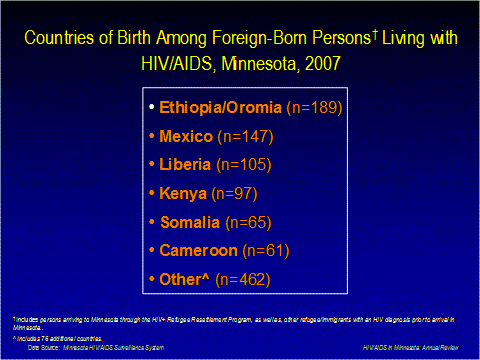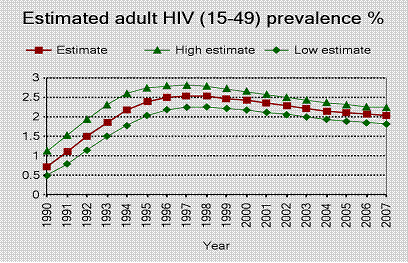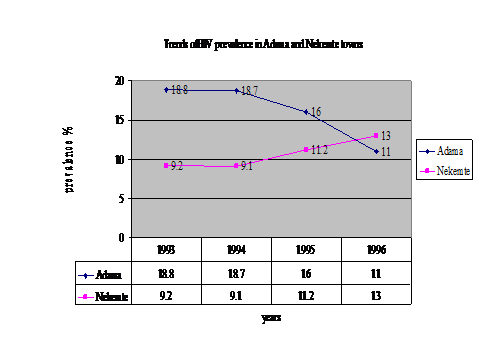 |
 |
 |
 |
 |
||
Articles
The State Of HIV/AIDS in Oromia and Among Oromo Diaspora
by Dr. Ibrahim Elemo, Translation by Damee Ormaa and Obsa Hassan / go back to Third IssueIntroduction:
The purpose of this essay is to provide general information about the current state of HIV and AIDS in Oromia and in the Diaspora Oromo communities. It intends to provide this information for scholars, students, and Oromo people in Oromia and abroad and make some recommendations for the way forward. It is based on data from published sources, the community-based research I have conducted, observations I made formally and informally as an HIV/AIDS-awareness-and-prevention organizer and during my tenure as director of HIV/AIDS projects and programs in Oromia, and my observations at Oromo Diaspora social and political events here in the US . However, it should be noted that the paper does not present the overall truth about the state of HIV/AIDS in Oromia. The main purpose is to share with others some of my experiences and the lessons I learned with others. I am so grateful to those who asked me to write this paper so that it can inform and possibly motivate some of my fellow Oromos to take action.Outlook of Global HIV/AIDS Epidemic
According to a UNAIDS’ 2008 report[http://www.unaids.org/en/KnowledgeCentre/HIVData/GlobalReport/2008/2008_Global_report.asp], the prevalence of global HIV has stabilized. It says that a significant progress has been made to prevent the spread of HIV, and some countries have also reported a decline in the number of new HIV infections and AIDS deaths. However, the number of people living with HIV has continued to rise. This is because more and more people are being infected by HIV and because people living with HIV/AIDS are living longer due to increased access to treatment. In 2007, there were an estimated 33 million people living with HIV/AIDS worldwide. The sub-Saharan Africa remains heavily affected accounting for 67% of all HIV infection and a reported 72% of all AIDS deaths in 2007.Status of HIV/AIDS in Oromia/Ethiopia
The information used to estimate the prevalence of HIV in Oromia was collected from two sources: from Antenatal Care Sentinel Surveillance survey and from blood sample obtained during the 2005 door-door study (Demographic and Health Survey). However, the estimates from these sources reached two different conclusions. Consequently, in 2007 the Ethiopian Ministry of Health put forth an estimate of HIV prevalence in Oromia and other regions. The estimates from Ministry of Health and similar institutions are therefore the primary source of available information.
Prevalence of HIV/AIDS in Ethiopia (source: UNAIDS Country Report 2008)In 2008, the number of people living with HIV in Ethiopia was estimated at 1,037,267. The national HIV prevalence among adult population was 2.2%. In Oromia, an estimated 248,229 people live with HIV. This makes HIV prevalence among adult population in Oromia to be 1.5%. The spread of HIV among the adult population in various cities in Oromia was estimated at 6.1% where as in the rural areas it was estimated at 0.6%.
Until recently there was no hope for persons infected with HIV, but in the past few years prevention of mother-to-child transmission (PMTCT) and antiretroviral therapy (ART) treatments are available at hospitals and health centers across the country.
In remote towns and rural Oromia such treatments were inaccessible because of the costs attached and lack of healthcare facilities that could provide these services within the reach of various communities. But since 2005, when such treatments started to be offered at no cost, the number of patients receiving HIV treatments has increased.
In 2008, of the 69,423 people living with AIDS who were eligible to get antiretroviral treatment, only 33,077 started taking the medications. Of these only 25,043 were continually taking treatment drugs. This means that half of the people living with AIDS who are eligible for treatment are not receiving the treatment. In 2008 alone, about 14,649 people have died of AIDS.
There are about 1,037, 267 children who lost their parents to HIV, Tuberculosis, Malaria and other causes. Orphans due to AIDS in Oromia in 2008 were estimated to be more than 205,194.
Status of HIV Prevention and Treatment among Oromo-Americans
There are large Oromo communities in Washington, DC, Minnesota, Seattle, Portland, Atlanta, Toronto and other states in North America. Over the last two decades, Oromo nationals have established community centers in those states where large numbers of Oromos reside. As more and more people are resettled from refugee camps, the numbers of Oromo immigrants have substantially grown over the years.Oromo refugees have endured significant challenges in refugee camps. In those often dire circumstances, many of them—especially the youth—were exposed to the danger of contracting HIV/AIDS. Migration contributes significantly to the spread of the HIV epidemic. In Oromia those who migrated to towns and cities in search of better life are at greater risk of contracting HIV. The same is true for Oromo refugees who left their country for political reasons.
Most refugees arrive in their countries of resettlement knowing of their HIV status. Those who came to the west with HIV infections have a better chance of living longer because of access to treatment for HIV and other related illnesses. These groups of HIV infected refugees also live a better and hopeful life compared to those living with HIV in Oromia because of access to better health care. This means that these HIV infected persons can live in a community without disclosing their HIV status to escape from the stigma. Thus, it is important to note that there are significant Oromo immigrants living in Diaspora who are infected with HIV.
Mostly the youth often fall victim to negative assimilation and integration which exposes them to higher risk of contracting HIV. Young people between 15–24 years account for the largest demographic group for new HIV infections. In any society, it is impossible to curb the spread of HIV without active guidance and education for the youth.

According to the Minnesota Department of Health (MDH), there were about 189 Ethiopia-born HIV-positive persons living in Minnesota in 2007. It is also known that Oromos account for more than half of all Ethiopia-born refugees in Minnesota. The MDH report also indicates that adult HIV prevalence among the Ethiopia-born refugees in Minnesota more than twice as many as the ethnic Somalis living in this state, even though the number of Somalis living in Minnesota is three times more than the number of Oromos.
Based on my observation at the Oromo Sports Federation in North America’s (OSFNA) annual soccer tournament, Oromo Studies Association convention, and other Oromo conferences in 2007, the efforts by community leaders and other actors to raise awareness about HIV among Oromo refugees is practically nothing or at its infant stage. This could be attributed to lack of awareness and/or effective leadership on part of community leaders. It is difficult to assert that the reason for this lack of effort is a lack of funding because there are abundant resources if one knows how to present the community need in a coherent manner.
Outlook on HIV Prevention and Care in Diaspora
Most of the educational materials available from HIV prevention and treatment centers focus on raising awareness about the ways in which HIV/AIDS is transmitted from one person to another. I have yet to see any form of information about stigma, discrimination, the need for voluntary HIV testing, and the timely initiation of antiretroviral treatment.Beside the limited services provided by the Oromo community with a grant from U.S. Department of Health, I have no knowledge of other institutions that take on HIV epidemic as a problem of our communities. As a health practitioner who worked directly with HIV prevention and care effort, after the formal and informal observations I made, and research I conducted to assess the extent of HIV prevention and control in the Diaspora , I believe all stakeholders can play a role to bring about behavioral change and guidance for our youth with very little effort.
For instance, famous Oromo artists can educate the public during soccer games about HIV, gang violence, drug use, etc., provided they are invited to participate and contribute by appropriate authorities. In addition, banners with information about HIV can be displayed at the soccer fields, or a group of young people can pass out flyers and talk with soccer fans about the spread of HIV. Even if it is hard to find an Oromo person living with HIV to come forward and educate the public about HIV, a collaborative effort with institution that work on HIV can help change a public opinion. For a success of such effort the role of Oromo political leaders and elites would be vital.
Outlook on HIV Prevention and Care in Oromia
- Objective and Administrative Problems
Oromia is a vast state with a large population. It is problematic to equate Oromia with smaller regions and provide the same capacity building supports. For instance, it is wrong and impractical to view Oromia and Harari or Benishangul-Gumuz regions as the same. Even when HIV Prevention and Care was provided in Oromia with funding from the World Bank and Global Fund, there were misguided policies and strategies from Ethiopian federal government’s administrative approach. As the result, there were unbalanced capacity building initiatives, and therefore, the efforts to curb the spread of HIV and provide treatment and care in Oromia lags far behind other regions. It has also proved to be a major obstacle to antiretroviral therapy (ART), Voluntary Counseling and Testing, and services to HIV orphans and HIV-infected and affected persons.
Oromia provinces were better off during the past regimes than under the banner of one Oromia during the incumbent regime. This is primarily because of incompetent leadership which is founded on the basic tenets of treating Oromia as a region than what it actually deserves to be treated—as a country.
- Problems with HIV/AIDS Program
Oromia is lagging behind other regions in many fronts. It is a horrible mistake to put the HIV/AIDS treatment and prevention program under the Ministry of Health. This is reversing the little gains that have been attained so far. Other regions such as Amhara and Afar administer their HIV prevention and treatment programs independently of the Ministry of Health. Currently, the Ethiopian Ministry of Health does not have the institutional capacity to organize all the multi-sectoral programs and initiatives. It could not even successfully direct the national TB and Malaria prevention and control programs effectively, let alone provide effective leadership to coordinate the fight against HIV epidemic. The motive behind that move is clear. It is to monopolize the huge Global Funds for TB, HIV, Malaria, and the World Bank Emergency AIDS Funds. The Oromia Health Bureau is in effect nothing more than an appendix to the Federal Ministry of Health; it should be an independent body entrusted with the mission of fulfilling the health needs of the Oromia state with accountability to its own national government and parliament.
- Problems with Human Resources
Oromia has fewer health professionals than any other region except for the Somali region. Hospitals and healthcare centers lack healthcare providers. In 2006, out of all medical school graduates, only one medical doctor was assigned to Oromia. This colossal failure is one major issue that is not well understood by Oromo political leaders at home and in the Diaspora. There were numerous hospitals and health centers built in Oromia. But none of them meet the cleanliness standards; they are shorthanded and underserved. Most hospitals in Oromia only have one or two doctors at best and no doctors at worst, which means that the number of lives that can be saved is needlessly lost. Although these are urgent needs that demand fundamental leadership and structural changes, there is little or no effort from Oromo political leaders to confront this reality.
- Problems with spread of HIV to Oromia (urban and rural areas)
In general, the spread of HIV in Oromia is below the national rate. However, the spread of HIV to major towns in Western Oromia warrants special attention. For example, in Nekemte, Jimma, and the surrounding coffee growing towns, or in places where there are road constructions and other business activities, HIV is spreading at a higher rate. Due to current investment patterns such as flower cultivation, there is an ongoing migration of people from rural to urban areas. Unless continual HIV prevention and education efforts are undertaken, there are ample reasons to believe that the HIV epidemic will soon expand to rural areas. This is one of the many lessons that can be learned from countries such as Uganda, where we have seen an increase in the HIV spread after an apparent stabilization of the epidemic.
HIV/AIDS Prevalence in The Urban and Rural Sites in Oromia (Selected Sites and Towns)
1992-1993
1996
1997
1998
1999-2000
2001
2002
2003
2005
Haramaya HC
2.50
2.20
1.30
Chiro Hospital
4.40
5.40
Adama
18.70
16.00
10.80
9.00
Shashamane
14.30
13.10
8.70
7.00
Moyale
5.10
Mattu
10.70
4.00
10.50
11.60
10.80
9.00
Jimma
8.60
16.90
10.20
8.30
Naqamte
9.10
11.30
13.00
10.40
Ayra Hosp
2.00
2.60
2.00
0.50
1.50
Ayuba (Arsi)
0.20
Begi
2.20
0.80
Dhadim/Yaballoo
1.70
0.90
1.00
1.20
Gosa/Bore
1.70
0.50
2.50
1.10
Dallo
8.50
3.10
Darra
1.90
3.80
Gambo
0.70
1.10
0.70
1.10
Ginir
3.10
Raytu
1.00
Tokko
4.60
2.20
2.90
Chawaqa
1.20
Masala
0.60
Amaya
3.00
Kokosa
0.50
- Lack of involvement from Oromo civic institutions
To overcome certain social and cultural barriers, the role of cultural institutions and traditional leadership is far more than that of religious counterparts, at least in some parts of Oromia. It is known that religious groups have been supported by the government and non-government stakeholders to raise awareness about HIV prevention and care for the affected. However, in the current political landscape, institutions like Gadaa and local self-help mechanisms such as Busa-Gonofa are not receiving similar recognition or being properly addressed . This is a problem that emanates from erroneous political viewpoints. To control the spread of HIV in rural Oromia, recognition and support for Oromo cultural institutions is much needed.
Conclusion
The lack of effective leadership for HIV prevention and control is rampant among the Oromo Diaspora organizations. Unless coordinated efforts are undertaken, the spread of HIV in Oromia and among the Oromo Diaspora is likely to continue at the current rate. In Oromia there is a greater need for fundamental structural changes, including changes to HIV programs. The healthcare system needs to be reformed. Unless these changes take place all concerned parties must understand that the problem of HIV epidemic in Oromia will be out of control in the long run. The Oromo public should strive collectively and/or individually to curb the spread of HIV/AIDS. Enhanced and Concerted efforts by all actors and stakeholders are a panacea for HIV and health tragedies in Ethiopia in general and Oromia in particular.______________________
Dr. Ibrahim Elemo is a Medical Doctor and a Public Health Specialist. Born and raised in Oromiya, he is the author of a book on HIV/AIDS in Oromiya entitled HIV/AIDS, Gender and Reproductive Health Promotion: The Role of Traditional Institutions among the Borena Oromo, Southern Ethiopia. He is the recipient of the 2005 Ethiopian Medical Association's Award for best scientific paper of the year. Presently, he is an Adjunct Professor at Harry Truman College and NWIHT in Chicago, Illinois.Damee Ormaa graduated from University of Minnesota with Bachelors of Art in International Studies and Political Science. He is currently working for University of Minnesota – Duluth as an Academic Advisor for Upward Bound Vision Quest, a Trio Program.
Obsa Hassan a first year medical student at the University of Minnesota Medical school-Twin Cities. Obsa previously served as the Public Relations Board Member for IOYA in 2007-08.

